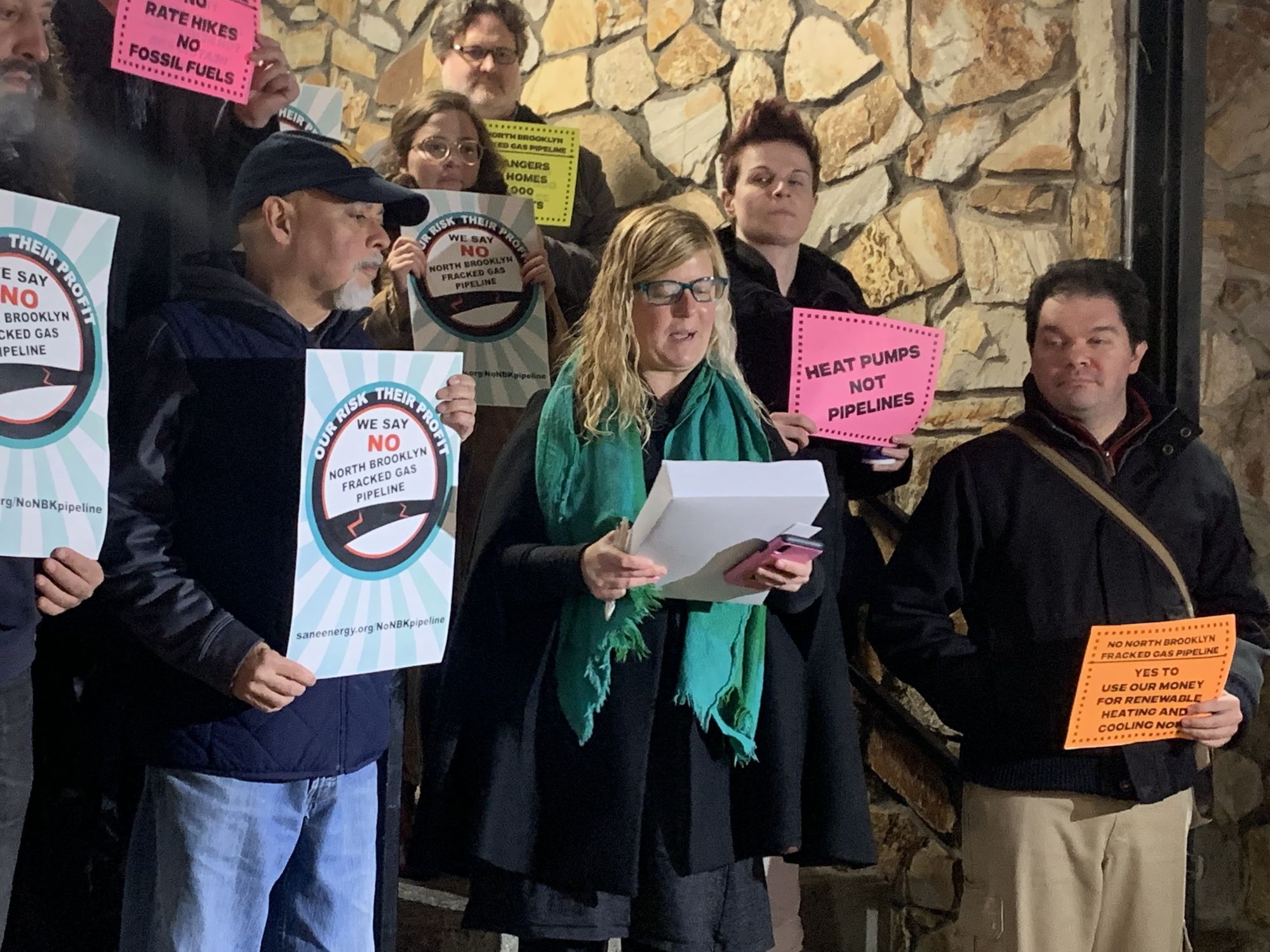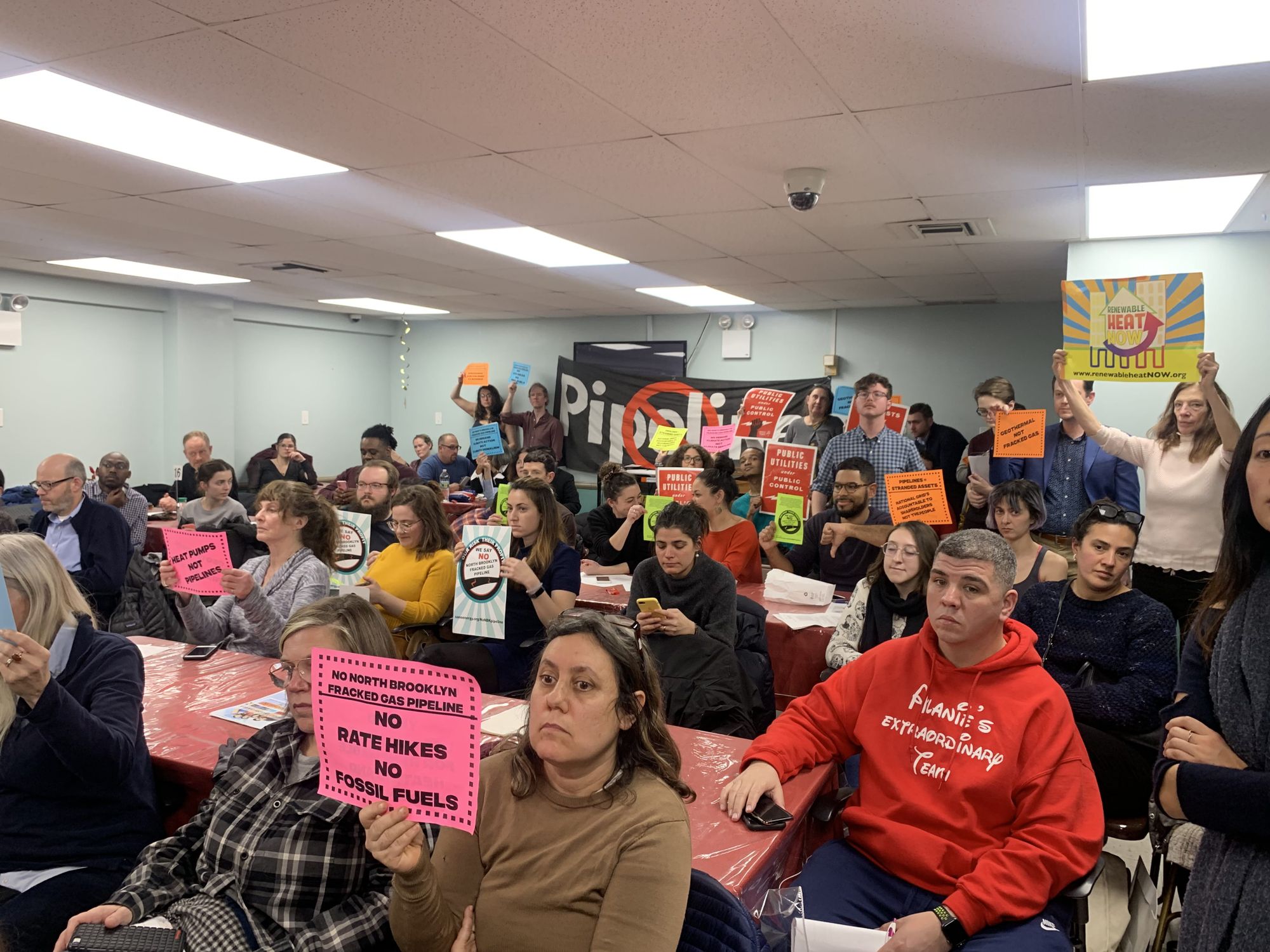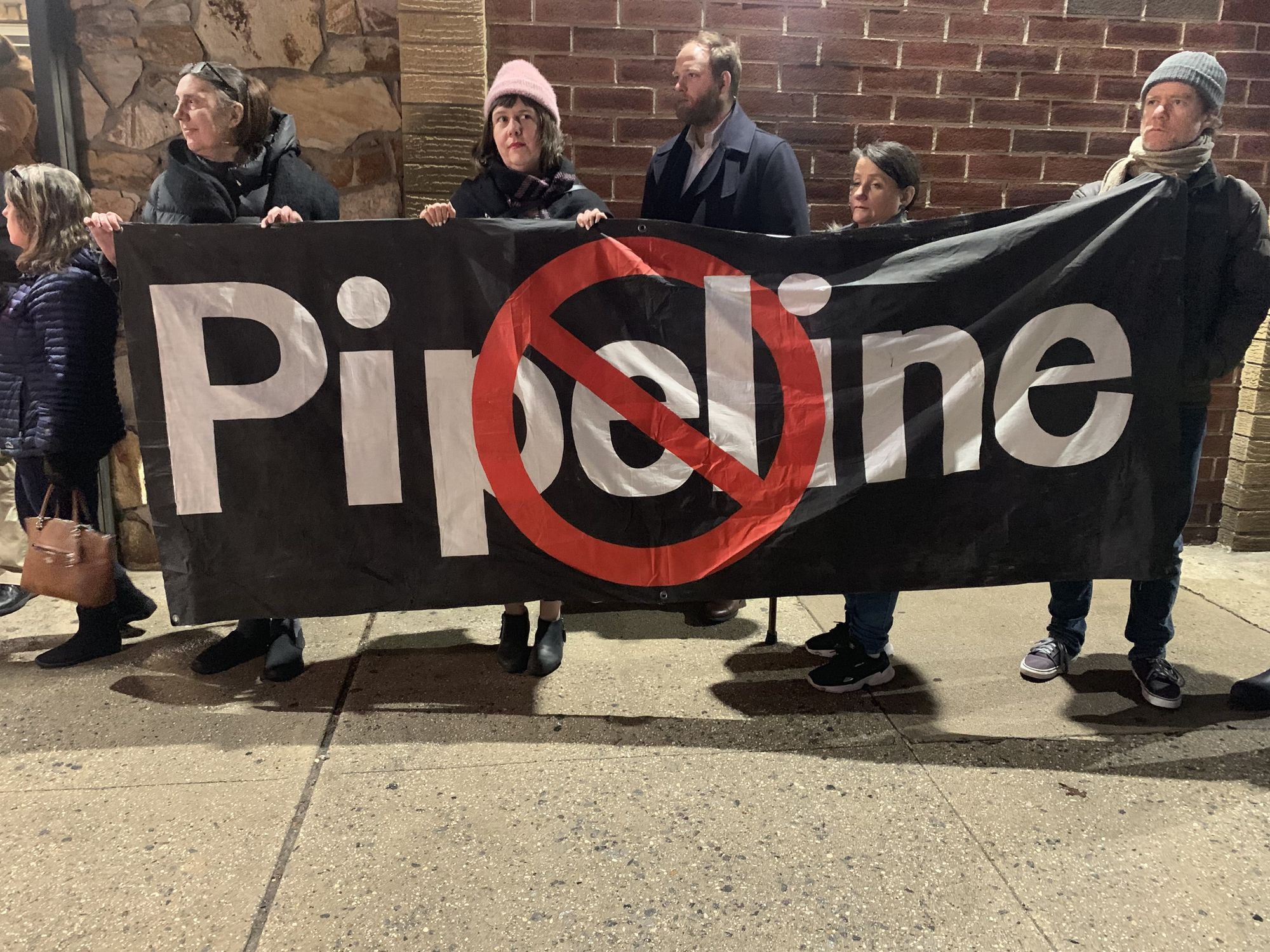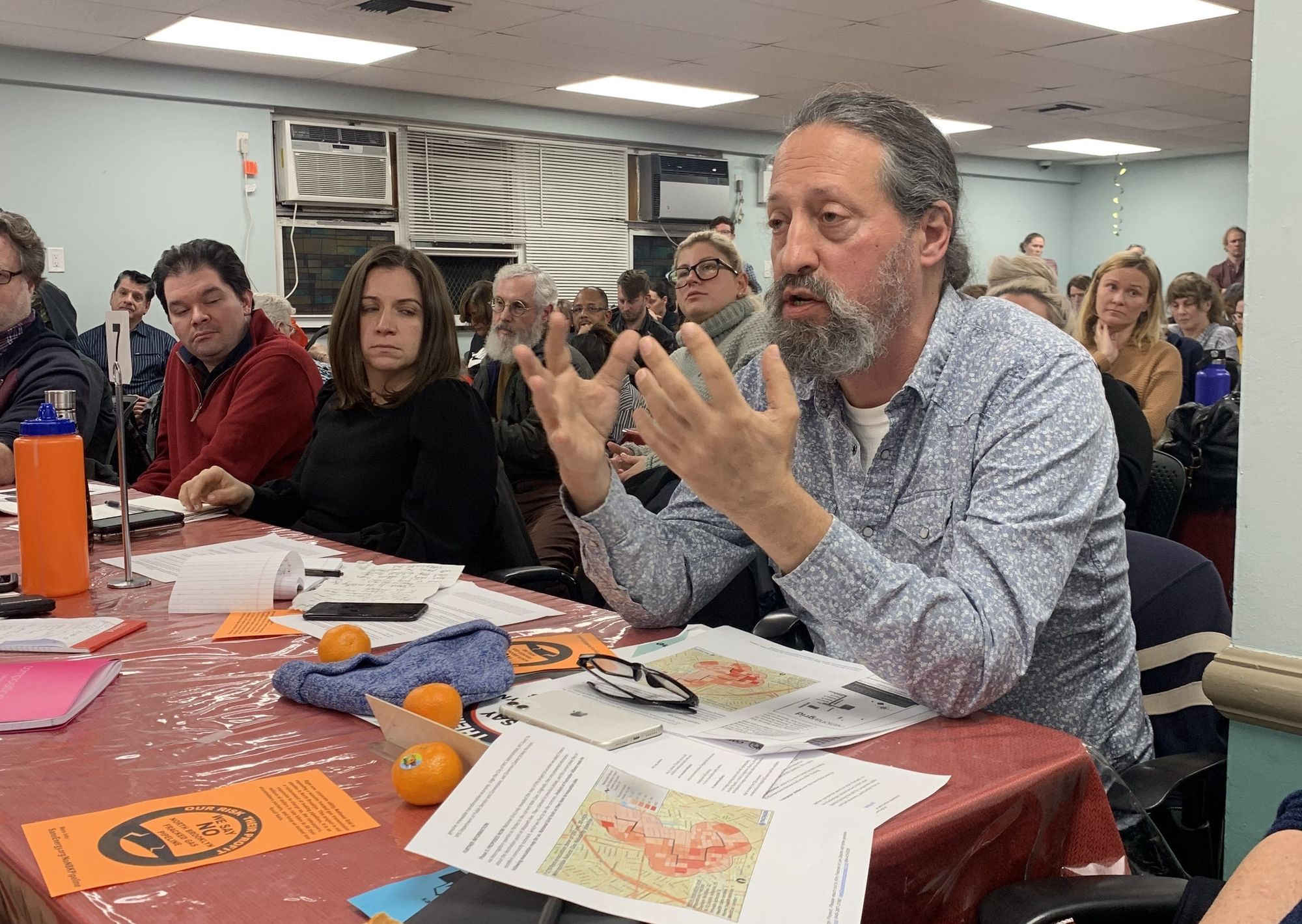‘Public Utilities Under Public Control!’ — North Brooklyn National Grid Pipeline Not Popular With Locals

WILLIAMSBURG — Over 50 Brooklyn residents of all ages lined up on the steps of Swinging Sixties Community Center at 211 Ainslie Street last night, ahead of the National Grid’s presentation of their new pipeline — the Metropolitan Reliability Infrastructure (MRI) project — to Community Board 1.
The project would “reinforce the backbone of the Brooklyn gas system” with a 30-inch, 36,000-foot pipeline, that would travel from Brownsville up through Greenpoint to the National Grid depot at Newtown Creek, according to the National Grid website.
The project would also “improve the gas system’s capacity to support the area’s economic growth,” according to a National Grid document posted on the East Brooklyn BID’s website.
In an email to Bklyner, National Grid media representative Karen Young explained that the project consists of five phases, which we’ve outlined below:
- Phase 1 began in the spring of 2017 and was completed in the first quarter of 2018 – spanning from Linden Boulevard to Thomas Boyland Street and Dean Street
- Phase 2 began in the spring of 2018 and was completed by the spring of 2019 – spanning from Thomas Boyland Street to Evergreen Avenue and Palmetto Street
- Phase 3 began in the first quarter of 2019 and was completed by the fall of 2019 – spanning from Evergreen Avenue and Palmetto Street to Central Avenue, Wilson Avenue, and Flushing Avenue
- Phase 4 began in October 2019 and is expected to be completed in fall 2020 – spanning from Flushing Avenue and Wilson Avenue to Montrose Avenue and Leonard Street
- Phase 5 is scheduled to begin in spring 2020 and is expected to be completed in fall 2021 – spanning from Montrose Avenue and Manhattan Avenue to Maspeth Avenue

The North Brooklyn Pipeline
New York activist group Sane Energy Project had called for a press conference ahead of the meeting to convey one clear message: we do not support this project. The pipeline would, they argued, bring fracked gas into the community, the extraction of which releases greenhouse gas methane and contributes to climate change. The pipeline also rejects what Sane Energy and Councilmember Rafael Espinal deem a need for renewable and sustainable energy sources, such as geothermal energy.
The project would significantly raise gas costs for National Grid customers as well. Though it does not refer explicitly to MRI, the Rate Filing 2019 page of the National Grid website states that its customers will see a monthly gas delivery increase equating to 17.78%, or 11.99% of their total bill.
At the press conference, Nichols Silbersack of New York City Comptroller Scott Stringer’s office said the comptroller called for a moratorium on all major natural gas infrastructure, stating that natural gas emissions are up 35% since 2005, “Doubling down on these fossil fuels is tantamount to climate denial.” Stringer is running for Mayor in the 2021 race.
Eric Radezky of Assemblyman Joseph Lentol’s office told the crowd that Lentol had worked with Community Board 1 to get National Grid to attend that night, and that Radezky himself had made multiple calls to National Grid asking them to show up.
Leslie Velasquez of El Puente, a local community human rights organization, spoke on the impact of climate change on communities of color.
“Being communities of color, we will be hit first and worst by climate change. We’re already feeling the effects so we are extremely alarmed by this,” Velasquez said. “And we’re not going anywhere. We’re going to stand here with all of our allies, for however long it takes. We’re in it for the long haul.”
Other community members spoke out against the pipeline, including Alvin Peña on behalf of Senator Julia Salazar, Legislative Director for Council Member Steven Levin’s office, Elizabeth Adams, and Wesley Higgins of the NYC Democratic Socialists of America.
The Community Board meeting kicked off just after 6 p.m.
Council Member Reynoso got up to speak saying he opposed the MRI project.
“At the moment, we’re not happy,” Reynoso said. “We’re hoping that we get some answers today. I have to be honest, I don’t think we’re going to get them. We should have a conversation as a community board about what corporations like National Grid are doing in our community, because if they’re not effecting positive change and providing a service that is more of a right than it is anything else, then we should be holding them accountable.”

National Grid Ensures Safety & Reliability
As the National Grid representatives prepared to speak, everyone that had flooded the room to show their opposition to the pipeline raised their signs. “No Rate Hikes. No Fossil Fuels,” said one. “Public Utilities Under Public Control,” said another. In the very back, a huge black banner simply said “PIPELINE” with a red No Signal in the middle.
National Grid Director of Customer and Community Management Keith Rooney gave the opening remarks.
“Everything we do is for safety and reliability,” Rooney said.
“Show of hands — how many people here use gas to power their home or their business?”
The question provoked confusion and frustration.
“Not a choice!” Multiple people in the audience responded. “All of us!”
Rooney went on to assert that National Grid is working toward the transition to clean energy, having invested hundreds of millions of dollars into companies that provide solar, wind, and other renewable energy sources. He then went on to reassure the audience that MRI is not a pipeline, and that National Grid is a “distribution gas company.” However, his colleague, Peter Metzdorff, would later go on to refer to the project as a “pipeline” in his portion of the presentation.
“This project started in 2017,” Rooney said. “It’s 80% complete — this is the last leg of the project.” It was approved by the Public Service Commission in 2017, he said.
Rooney also made the case that National Grid should not be viewed as the enemy. “We are embedded in the communities here, and we’ve been here for over 100 years, and we’re proud to serve you,” Rooney said.
Manager of Strategic Assets Peter Metzdorff said that the project would not bring additional gas into New York City, referring to it as primarily a “reliability project” that connects “one portion of our transmission system into another portion of the transmission system.” He said that “the project is there to enhance Brooklyn’s natural gas system for the 1.3 million customers that we serve within Brooklyn, Queens, and Staten Island.”
Metzdorff specified that National Grid had been working on phases four and five of the MRI project for the last few months. The original three phases had been completed, he said. The goal is to bring the pipeline from Brownsville up through Newtown Creek in Greenpoint. The panel did not provide further information about what the individual phases themselves included, nor is the information readily searchable on the National Grid website.
Other members of the panel, like Fabio Perla, who does outreach for National Grid, stated that they were doing everything in their power to inform the community of the work National Grid is doing on the pipeline, including speaking with residents, business owners, and management companies. Renee McClure, Manager of Community and Customer Management, said that the company had held a meeting with Community Board 16 in Brownsville back in 2017.

“We don’t want this pipeline!”
After the panel concluded, a lineup of over a dozen community members gave impassioned presentations on the devastating effects that the pipeline would have on the community.
Greenpoint resident Deborah Spiroff said, “you are putting this in a neighborhood where people and generations have died. Children – it is normal that they are tested, and have lead in their blood. So we can’t believe what people are telling that ‘yeah, believe us, it’s safe.’”
Greenpoint resident Kevin LaCherra turned around during his presentation, speaking directly to the National Grid panel: “We don’t want this pipeline! We want National Grid to invest in renewable energy now! Climate emergency is coming, and we don’t have any time to waste.”
Kim Fraczek and Lee Ziesche of Sane Energy Project also spoke, as well as Steve Fox of public advocate Jumaane Williams’ office.
Fraczek held up an evacuation zone map, which she said Sane Energy had put together with FracTracker Alliance when National Grid admitted to them that they hadn’t done any evacuation zone studies in the case of an explosion or other pipeline malfunction. “My house is in that evacuation zone, and so [are] 49,000 other people,” Fraczek said.
Ziesche said during her presentation, “I don’t understand why we all didn’t get an email saying that this pipeline was coming way back in 2016,” to whoops and applause.
LaCherra later asked the panel directly how long they had known that phase four was coming.
“How long?!” Multiple attendees shouted.
“It was probably finalized in 2016,” said Rooney.

“We notify the community as we move through the process,” said McClure. The comment inspired an angry uproar from the audience.
Audience members were altogether dissatisfied with the responses from National Grid. They wanted answers – about what their evacuation plan was in the case of an explosion or other pipeline malfunction, about why they hadn’t systematically notified everyone in the communities where and when the work on the pipeline was taking place. They wanted to know why they weren’t being heard, and why National Grid refused to give the community a platform in the decision process for this kind of project.
LaCherra told Bklyner after the meeting wrapped up that he believed that the community wants a commitment from National Grid to renewable energy, “This pipeline does not work for us.” He said that he hopes Governor Cuomo and other politicians hear them loud and clear.
“I am hoping that those that are in power do the right thing here by this community, because these companies won’t,” he said.
The article was updated January 17 with information from National Grid about the MRI project phases.
Sane Energy Project will hold a public information session on January 23 at 6 p.m. at the Bushwick library, 340 Bushwick Ave.




